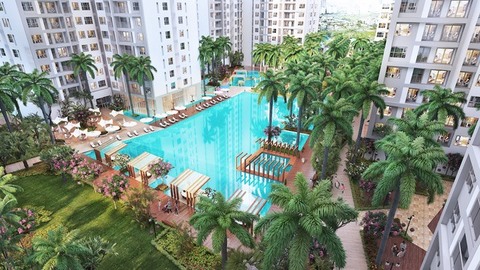
The real estate market in the southern province of Dong Nai still lacks a strategy to develop and attract high-powered investors, despite its many inherent advantages.
The real estate market in the southern province of Dong Nai still lacks a strategy to develop and attract high-powered investors, despite its many inherent advantages.
Dong Nai has a convenient and well-connected location that is on the main road of National Highway 1A and HCM City – Long Thanh – Dau Giay expressway. Plans are being drawn to build the country’s largest international airport, Long Thanh, in the province.
 |
| The real estate market in the southern province of Dong Nai still lacks a strategy to develop and attract high-powered investors, despite its many inherent advantages.— Photo dantri.com.vn |
Dong Nai’s tourism sector is growing significantly thanks to the construction of Pham Van Dong road linking Tan Son Nhat international airport with Dong Nai’s Bien Hoa City and the expansion of the National Highway 1A, reducing travel time between HCM City and Dong Nai Province.
In addition, at the end of 2017, HCM City approved the construction of the Metro No. 1 line connecting Ben Thanh station (District 1, HCMC) to Bien Hoa City.
Dong Nai is one of the leading localities in attracting foreign direct investment (FDI). Last year, the province attracted US$1.25 billion of FDI and disbursed $1.1 billion. This capital flow is mainly used to develop factories in industrial zones. Nicknamed "the capital of industrial parks” in recent years, Dong Nai has also been developing its services and entertainment.
Millions of workers and thousands of foreign engineers are living and working in the province with high income levels, indicating a huge demand for housing. According to a survey by the Construction Department of Dong Nai Province, 80 per cent of employees in the province see a need for more sustainable housing.
Despite this need and the province’s many advantages, however, the development of the real estate market in Dong Nai is lagging. Su Ngoc Khuong, investment director at Savills Viet Nam, told the newspaper Bao dau tu that Dong Nai currently has about 300 projects that have been clearing ground with financial backing from buyers.
However, these projects are mostly small-scale, spontaneous and unplanned, without large high-end projects. There are barely any plans for apartments and street-side villas, even as the number of wealthy people who want such accommodations is rising.
Khuong added that the province can meet its development potential only with better planning by authorities and greater efforts to attract professional investors.
Fluctuating market
At present, the real estate market of Dong Nai is very active in the segment of land, as investors purchase plots and wait to sell them at a higher price. The market is especially high-powered in Long Hung, Tam Phuoc and Hoa An communes.
In these regions, the projects are mainly plots of dozens of hectares, subdivided by investors or sub-investors for constructing infrastructure and then reselling. From late 2017 until now, land prices in these areas have increased quite significantly, from 10-20 per cent.
In particular, in Hoa An Commune (Bien Hoa City), adjacent to Di An Town (Binh Duong Province), residential land of 100 square metres, with a certificate of land use right (red book), will be sold at a price of VND1.2 billion. Similarly, in many places in the central area of Bien Hoa, housing prices also constantly fluctuate with an average monthly increase of 10 per cent over the previous month, ranging from VND60-80 million per sq.m, in recent months.
The most notable attraction of Bien Hoa City is the project of Long Hung open economic eco-urban area, located along the Dong Nai River, adjacent to HCM City. In early 2017, this project was offered at an average price of only VND7-8 million per sq.m, but now it has increased to VND16.5 million per sq.m. Despite the price increase, the liquidity of this project is quite high.
Nguyen Thanh Lam, deputy director of Dong Nai Department of Construction and chairman of the Dong Nai Real Estate Association, said that in 2016, when the information of Long Thanh International Airport was launched, investors poured money into Dong Nai to purchase land, making the real estate market of the province more active, but the local government also had difficulty in controlling selling prices.
Many spontaneous projects have disrupted the general planning of Dòng Nai; therefore, the province has strengthened market management by dividing the land into smaller plots to be sold to developers and investors.
At present, Dong Nai real estate market is bouncing back, but only on a small scale and with activity largely driven by investors. Most of the secondary investors are buying for profit, while people in need of housing struggle to find move in-ready accommodations.
According to Lam, in the outskirts of the province, many new projects have been opened for sale and many of them have been sold out. No one has come to live in the projects, however, because while technical infrastructure including roads and utilities is in place, social infrastructure like schools and hospitals is lacking.
The investors who purchased the units in the projects must therefore wait for the social infrastructure to be built before they can sell to homebuyers. This situation represents a waste of resources, Lam said, that would be better spent on real estate development and investment in areas where people could move in immediately.
(Source:VNS)





